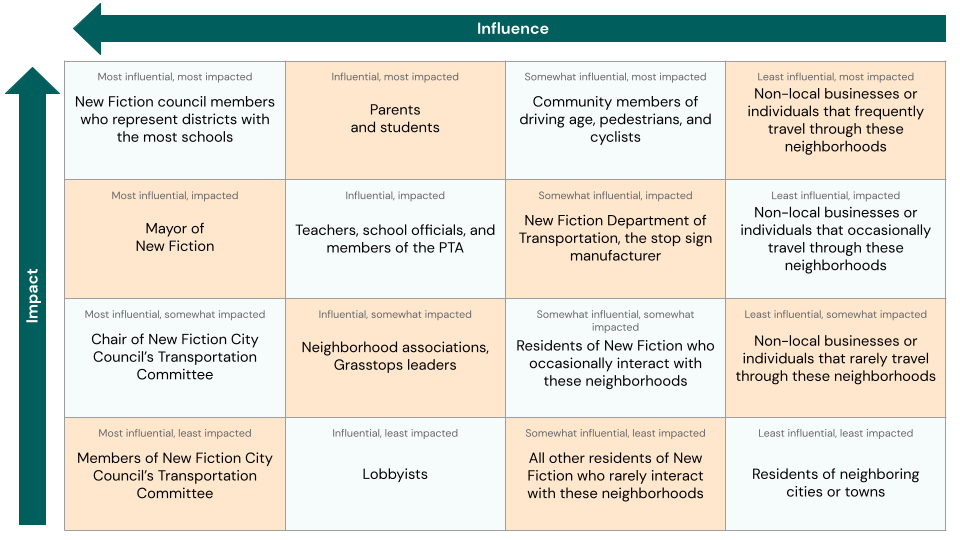Advocacy efforts are most powerful and effective when all voices surrounding an issue come together and speak one unified truth. However, finding common ground amongst advocates may not always be possible. In these situations, the best way to discover points of alignment and find a path forward is through stakeholder engagement.
Stakeholder engagement is the cornerstone of a well-designed government relations strategy. It involves creating a strategic plan to identify, engage, collaborate, and communicate with key individuals or groups that may be impacted by or influential towards your advocacy priorities. Understanding and utilizing an effective strategy can set your advocacy goals up for success and help avoid any potential headaches along the way.
In this article, I’ll discuss the who, what, why, and how of an effective stakeholder engagement strategy along with some additional tips I’ve found useful in the field of government relations.
What is Stakeholder Engagement?
At its most basic level, stakeholder engagement is the process of identifying, developing and maintaining relationships with specific individuals or entities that are impacted by or have influence over the issues or goals that are important to your organization.
Understanding the groups that have a stake in your organization and their priorities, needs, and capabilities will aid in the development of shared advocacy goals and opportunities to collectively work toward achieving them.
Why is Stakeholder Engagement Important?
Stakeholders can have a dramatic impact, for better or worse, on your organizational goals and the issues you care about.In some cases, stakeholders can deliver more impact than your organization could ever hope to have on its own.
Some key benefits of developing a robust stakeholder engagement strategy for your organization include proactively identifying shared goals, common threads of understanding, and pain points within their stakeholder class. Stakeholder engagement strategies also help organizations develop a holistic approach to advocacy that brings every available voice to the table.

Who are Stakeholders?
Generally, stakeholders are anyone who has a stake in an organization — be it a financial stake (say a stockholder or an employee), a stake in the outcomes produced by the organization, or maybe even a personal interest as a fan or devotee of the organization’s cause. In some cases, your stakeholders will be the best messenger of your cause and could also be the most impactful people when it comes to moving the needle forward. Understanding the needs, wants, and capabilities of your stakeholders is pivotal to the success of your organization and a crucial part of a successful government relations strategy. Building relationships and nurturing lines of communication with your stakeholders will give you more insight into your issue area from multiple vantage points, allowing you to develop a more robust and nuanced advocacy approach.
For the most part, your stakeholders sit on a spectrum directly drawn from the impact your goals will have on their personal and/or professional lives. As such, the outcome you seek defines those you must engage throughout the stakeholder engagement process.
In many cases, the goals of your organization will define your stakeholders. Working backwards from the end result you seek can help illuminate the stakeholders you must engage. Ask yourself questions such as:
- What is the specific desired outcome? Passing legislation, repealing regulations, winning a campaign?
- Who will most effectively help achieve these goals?
- Who is best situated to prevent success if not engaged properly?
- When is the most impactful time to engage specific sets of stakeholders?
These questions are a good place to start, but every situation will require an additional set of specific questions you must ask yourself to build out a map out your stakeholder class and further hone your overall strategy.
How to Map Your Stakeholders
In my experience with government relations work, I’ve come across a number of ways to map out stakeholders. I’ve found it helpful to break down stakeholder groups into tiers based on level of influence and decision-making power and, further, subgroups within each tier based on the extent to which the stakeholder will be impacted by the expected outcome. This exercise illuminates two key elements that are helpful in putting together an advocacy strategy: first, the reach of a stakeholder’s potential influence on the desired goal; second, their motivation or potential motivation toward taking action to achieve the desired goal.
Example: Stakeholder Mapping in New Fiction, USA
As an example, let’s say our desired goal is to pass legislation in the town of New Fiction to increase the number of stop signs near schools.
The most influential stakeholder on this issue would likely be anyone who has a direct say or vote in determining the outcome — the chair of the city’s transportation committee, council members on the committee, and the mayor of New Fiction. Next, is who’s likely to be impacted the most — students, schools, their neighborhoods, and council members who represent districts with the most schools.

It’s at the crossroads of influence and impact that we see a fourth impacted group, council members representing districts with schools. This group has access to the most influential individuals on this issue, as well as a say in the process themselves. Therefore, they should be our most sought after and targeted stakeholder.
Want to get started on your own stakeholder mapping? Download our free, fully-customizable stakeholder mapping visualization tool today!
Engaging Key Stakeholders in Strategic Planning
Engage Before
Before beginning the planning process, it can be useful to get a sense of the goals and priorities you share with your key stakeholders.This can be accomplished either through polling, interviews or surveys and in person meetings with one or more of your stakeholder groups. Mapping your stakeholders will likely illuminate which groups should receive more intensive engagement, such as a face-to-face meeting and ongoing communication, or a one-time survey.
The information gleaned throughout this process should guide your internal strategic planning process and help to ensure all your bases are covered regarding your stakeholder class.
Engage During
Once you have a plan in place and have mapped out your stakeholders, a communication strategy is necessary to ensure important and useful information is shared with your stakeholders. This strategy should create a two-way communication structure that will allow your organization to provide and receive pertinent updates and allow your stakeholders to deliver any feedback. Periodic check-ins, briefings, and even happy hours can be useful tools to facilitate discussion.
It’s important to remember that each group of stakeholders will require their own unique mode of communication to most effectively meet their needs and to ensure they are properly engaged in this process. For instance, stakeholders such as the community organizations that you partner with and the lobbyists you hire should probably not be on the same weekly check-in. These two entities serve separate purposes and use different approaches to achieve their desired outcomes. If there is a specific reason they should be receiving the same information, host a separate special briefing. Generally speaking, the method of engagement for each of your stakeholders should be unique in order to meet their respective needs.
Engage After
Once your strategic plan is complete, it’s time to share your findings and receive last minute stakeholder feedback before advocacy begins. Debriefs or large gatherings of your stakeholders can be a great way to disseminate this information. Holding a second round of smaller meetings with key stakeholders where you can dive into the information with a bit more detail may also be a good idea, depending on the complexity of your advocacy issues or goals.
Ongoing Stakeholder Engagement
As you and your team execute your strategic plan, remember to take advantage of opportunities to continually develop your stakeholder relationships through as many modes as possible. This includes, but is not limited to: events, check-ins, information exchanges, and feedback discussions. These interactions will provide ample opportunities for your organization to find new avenues for advocacy and deepen the bond between you and your stakeholders, which will ultimately increase trust – the secret sauce of stakeholder engagement.
Along this same line, continue to evaluate your stakeholder map as individuals and groups will evolve from year-to-year, and even month-to-month. The advocacy landscape is ever-changing and effective engagement can only be done with up-to-date information. Outdated Information leads to ill advised assessments and poor advocacy outcomes. It’s imperative to keep a close eye on the viability and accuracy of your stakeholder map along with your organization’s strategic plan.
Finally, be flexible and keep your options open. It’s best to have multiple or overlapping stakeholders with influence in key areas of your advocacy issue areas. Elected officials and their staff come and go, and stakeholder groups may shift their advocacy focus or level of involvement. Always be prepared to manage the risk of a potential gap in bandwidth and continue to cultivate relationships within your issue purview.
Ready to supercharge your stakeholder engagement? Download our free, fully-customizable stakeholder mapping visualization tool now.
Orlando Jones is the Deputy Director for Government Relations at the Secure Elections Project.

